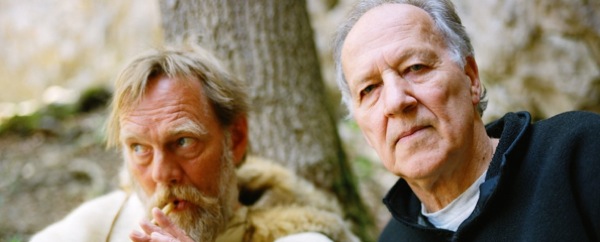
I Can’t Get Werner Herzog Out of My Head
Art, Art NewsI feel guilty leaving a biennial, triennial, or any other group exhibition with only one artist on my mind. These events are supposed to expose the viewer to a variety of creators, styles, and media—not incite a sick obsession with a specific work. After attending the 2012 Whitney Biennial, I’m still thinking about Werner Herzog’s video installation and wondering if my transfixion is bordering on the obsessive.
In preparing the Whitney Biennial—which focuses on the best and brightest of the contemporary art world every two years—the curators asked the acclaimed German filmmaker to contribute to the exhibition. Herzog, known for such films as his recent Cave of Forgotten Dreams and the 1972 classic Aguirre, the Wrath of God, initially refused the curators’ request—claiming that he is no artist. But I couldn’t be happier that Herzog changed his mind, creating a breathtaking five-screen video piece titled “Hearsay of the Soul.”
Herzog fills a large room in the Whitney’s second floor gallery space with enlarged projections of 16th Century paintings and etchings. The works—enchantingly impressionistic landscapes—are by a relatively unknown Dutch artist, Hercules Segers. Haunting and melodic music occupies the darkened room—accompanying close-up and panning shots of Seger’s works. The landscapes seem to slowly dance around the space, shifting from dark nighttime scenes to snowy mountainscapes to portrayals of pale yellow countrysides that resemble those of Van Gogh. Slowly, the chanting music in the background shifts to a hypnotizing score played by the Dutch cellist Ernst Reijseger. Reijseger then appears on screen, arched over his cello, mesmerized by the music he is making. As Reijseger plays, the paintings fade in and out around him and the music seems to vibrate from the walls.
“Hearsay of the Soul” is more than a video—it cannot simply be watched, it must be experienced. Seeing the installation means entering through a curtain of heavy, black plastic and emerging inside a dark room filled with foreign imagery and unfamiliar music (unless you’ve seen Cave of Forgotten Dreams, where Herzog uses Reijseger’s same score). In essence, Herzog’s video is just pictures of paintings and etchings projected onto a wall. But in projecting these works in such a way, Herzog puts the works into the viewer’s physical space. Seger’s landscapes are on every wall, serving as the room’s figurative wallpaper. Herzog’s lens zooms in and out, and the paintings glide past, forcing viewers to engage with the work in a way that would be impossible if the pictures remained in a frame. In magnifying Seger’s work in such a way, Herzog lifts the artist out of oblivion and into the contemporary gallery space.
In his statement about the installation, Herzog is quoted as calling Seger “the father of modernity in art.” He clearly has an agenda, and perhaps an overbearing one at that. But I wasn’t so compelled by the work because Herzog brings to life an old, dead artist—pairing paintings with beautiful music. With his installation, Herzog is suggesting something other than reconsidering a forgotten Dutch artist. In a way, he’s suggesting a reconsideration of art itself.
Herzog calls Seger’s landscapes “not landscapes at all” but “states of mind; full of angst, desolation, solitude, a state of dreamlike vision.” For Herzog, Seger’s work stands out as something that is reflective of an inner agony and ecstasy essential to the human soul. Maybe Herzog’s goal here is a little lofty or even a bit overwrought. But at a very basic level, the installation brings attention to the process of artmaking—which is often an agonizing and ecstatic feat. Every element of the installation—the projected paintings, the video of Reijseger, the captivating music—all work together to draw attention to the painful, beautiful, and mystifying act of creating.
Herzog establishes a narrative of creation—from Seger’s relatively unknown but soulful landscapes to Reijseger’s euphoric playing of the cello. In “Hearsay of the Soul,” hundreds of years of artistic effort exist in a sort of contained continuum. Herzog pays homage to the artists of the past (like Seger), those living in the present (like Reijseger), and incites the viewer to contemplate where human creativity will extend in the future. In a contemporary art world often fueled by a focus on products (and price tags), it’s moving to see something emphasizing the importance of process and the value in creation. So moving that it just won’t leave my memory.
























